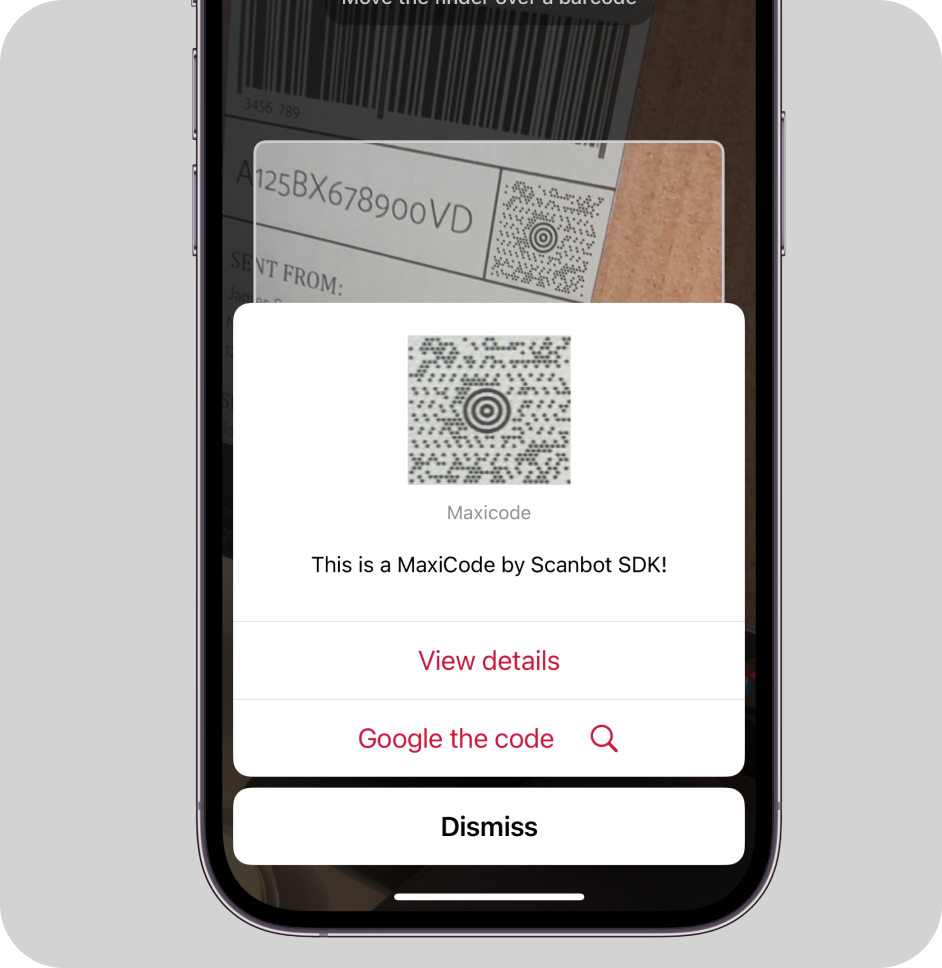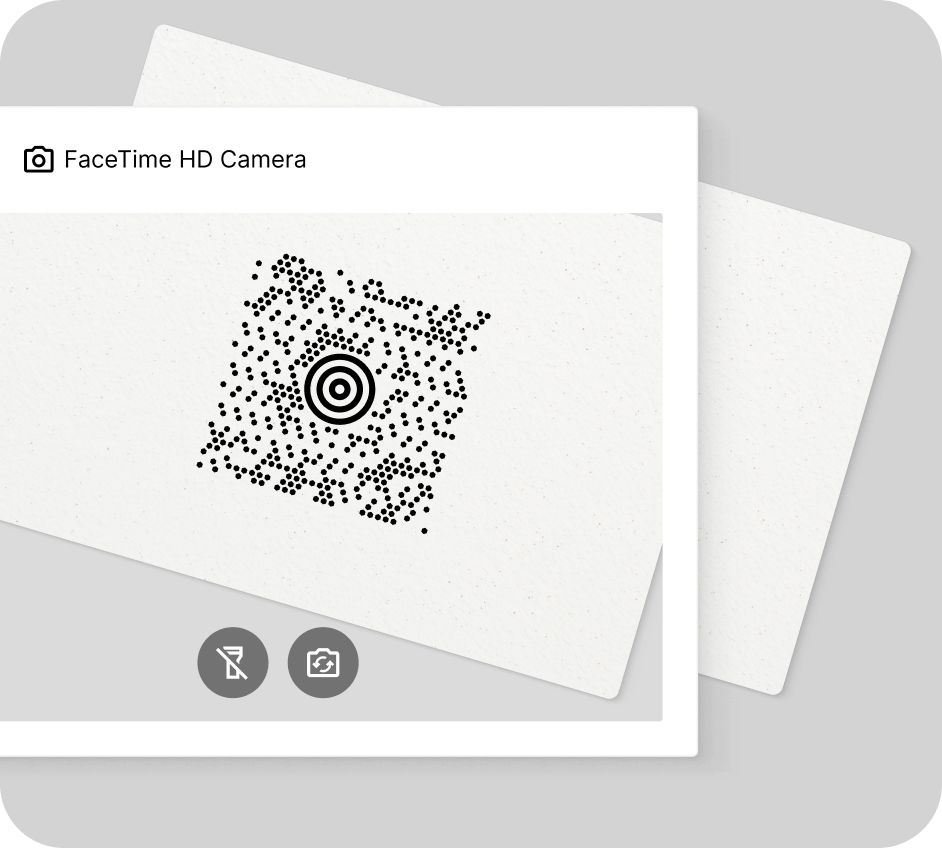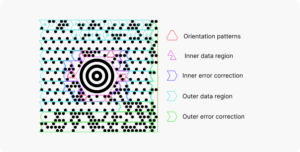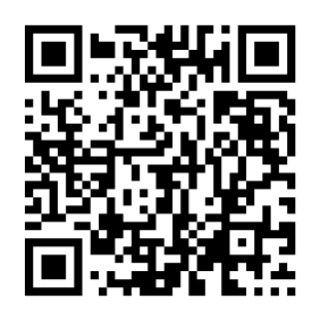MaxiCode Reader
Add MaxiCode scanning to your mobile application or website
Trusted by
400+
global
industry leaders
Turn smartphones into fast & reliable MaxiCode scanners
The Scanbot MaxiCode Scanner SDK delivers exceptional performance, easily reading codes even when damaged or at an angle. With a scanning speed of under 0.04 seconds, your users get instant reads for seamless workflows.
Key benefits include:
- Offline scanning: The Scanbot SDK works 100% on-device, ensuring both uninterrupted performance and data security.
- Enterprise support: Questions or requests? Contact our technical support team. We’re happy to assist you.
- Flat pricing model: Cost stays the same no matter how much your user base or scanning volume grows.


How this scanning tool works
Our free online MaxiCode reader scans codes directly through your camera or on imported images. This barcode reader works in any browser, no app download or signup needed. Enjoy real-time camera view scanning or decode barcodes on pictures in seconds – just point your tablet, laptop, or mobile phone camera at the MaxiCode or import an image file to instantly access the encoded data.
This tool is powered by the Scanbot Barcode Scanner SDK!
(We don’t store any images or data you import. Everything stays on your device.)
Understanding MaxiCodes
What is a MaxiCode barcode?
The MaxiCode is a two-dimensional (2D) barcode developed by United Parcel Service (UPS), primarily used for quick and accurate scanning of parcel information in logistics and shipping. It features a unique hexagonal grid pattern with a central circular bullseye, enabling efficient scanning from any angle.
MaxiCode can encode up to 93 alphanumeric characters or 138 numeric characters, and generally stores shipping information like postal codes, tracking numbers, and service class codes.
It employs the Reed-Solomon error correction algorithm, enabling scanners to detect and correct symbol errors and burst errors, ensuring reliable data recovery even if part of the barcode is damaged.
This design makes MaxiCode particularly well-suited for high-speed environments, especially rapid package sorting and tracking.
Structure and components
MaxiCode symbols nominally have a fixed size of 1.11 x 1.054 inches (28.14 x 26.91 mm), including quiet zones. They consist of the following key elements:
- Central finder pattern: The distinctive bullseye consists of three concentric black circles that allow scanners to recognize and align the symbol.
- Data regions: A grid of 33 alternating rows, each consisting of 29 or 30 hexagonal modules that contain the encoded data.
- Orientation pattern: Six fixed patterns surrounding the bullseye that help scanners determine the symbol’s orientation.
- Quiet zone: Blank areas around the MaxiCode that ensure proper scanning and readability.

Encoding
MaxiCode uses different code sets for data encoding:
- Code set A: Uppercase letters, numbers, and 15 common punctuation marks.
- Code set B: Lowercase letters and other punctuation marks.
- Code set C: Multilingual uppercase letters and special graphic characters.
- Code set D: Multilingual lowercase letters and special graphic characters.
- Code set E: ASCII characters 0–31, 149–160, 162–167, 169, 173–174, and 182.
MaxiCode messages and data modes
The information in MaxiCode barcodes is split into two messages, primary and secondary. MaxiCode barcodes also support several data modes, each with a specific purpose and data structure.
For logistics uses, the MaxiCode contains a Structured Carrier Message (SCM), which is laid out as follows:
- Primary message (mandatory): Encodes a postal code, a 3-digit country code (standardized in ISO 3166), and a 3-digit service class number assigned by the carrier.
- Secondary message (optional): Stores additional address data and other relevant information.
MaxiCodes can also hold general-purpose data, in which case the primary and the secondary messages are simply joined together. Here are the available modes:
| Mode | Data structure | Purpose |
| Mode 2 | Structured Carrier Message with numeric postal code (up to 9 digits) | UPS domestic shipping (typically US destinations) |
| Mode 3 | Structured Carrier Message with alphanumeric postal code (up to 6 characters) | Global shipping |
| Mode 4 | General data | Encoding general information, without mandatory data fields. |
| Mode 5 | General data | Encoding general information using full enhanced error correction for primary and secondary messages. |
| Mode 6 | Programming instructions | Programming hardware devices, especially barcode readers. |
Note: Mode 0 and Mode 1 are obsolete.
Error correction
MaxiCode uses Reed-Solomon error correction with two levels:
- Standard Error Correction (SEC)
- Enhanced Error Correction (EEC)
The primary message always uses EEC in all modes. The secondary message uses SEC except in Mode 5, which offers the best overall error protection by using EEC for both messages, at the cost of capacity.
Applications of MaxiCode barcodes
Logistics and shipping
MaxiCode barcodes are extensively utilized by courier services like UPS and DHL for routing, managing, and tracking domestic and international packages. They encode detailed shipment information, enabling real-time tracking and high-speed sorting. UPS itself uses Mode 2 for domestic and Mode 3 for international shipments.
Retail
In retail environments, MaxiCodes help manage stock levels and monitor product movement across supply chains, facilitating accurate inventory control and timely replenishment.
Manufacturing
MaxiCodes are used to track products and parts throughout production processes, enhancing operational efficiency and quality control.
Advantages of MaxiCode barcodes
- Compact: They store up to 93 alphanumeric characters or 138 numeric characters in a shape suitable for various packaging types.
- Error correction: MaxiCode uses Reed-Solomon error correction to accurately retrieve data even if the barcode is partially damaged or obscured.
- Structured messaging: The primary message (postal code, country code, and service class) can be read reliably at very high speeds for sorting and routing. The secondary message (any additional shipment details) does not need to be decoded unless necessary).
- Omnidirectional scanning: The hexagonal grid design with orientation patterns enables scanning from any angle.
Why choose the Scanbot SDK for MaxiCode barcode scanning?
The Scanbot Barcode Scanner SDK is specifically designed to handle the challenges of decoding MaxiCode barcodes in real-world scenarios.
What sets us apart:
- Exceptional performance: Reliably decodes even damaged, low-contrast or distorted barcodes.
- High-speed scanning: Read MaxiCodes in as little as 0.04 seconds.
- Cross-platform compatibility: Easily integrate with Android, iOS, cross-platform, web, Windows, and Linux platforms.
- Customizable UI: Customize the ready-to-use components to match your app or website design.
- Privacy-first: Operates offline for complete data security.
Whether your use case involves MaxiCode codes, QR codes or any other barcode, the Scanbot SDK delivers the accuracy, speed, and reliability you need to succeed.
Related Barcode Types:
- Data Matrix Scanner
- QR Code Scanner
- PDF417 Scanner
- Aztec Code Scanner
- Code 128 Scanner
- Code 39 Scanner
- EAN Scanner
- UPC Scanner
- Micro QR Code Scanner
- GS1 DataBar Scanner
- GS1 DataMatrix Scanner
- GS1-128 Scanner
- ITF Scanner
- Codabar Scanner
- Intelligent Mail Barcode Scanner
- rMQR Code Scanner
- Royal Mail Scanner
- Micro PDF417 Scanner
Frequently Asked Questions
What is a MaxiCode barcode?
A MaxiCode is a two-dimensional barcode developed by United Parcel Service (UPS) featuring a hexagonal grid with a central bullseye. It encodes up to 93 characters and uses error correction for reliable data recovery even when damaged.
Where are MaxiCodes used?
MaxiCodes are primarily used in logistics on shipping labels for tracking packages. They are also utilized in retail for inventory management and in manufacturing to track products and parts during production.
How can Scanbot SDK help you with MaxiCode barcode scanning?
The Scanbot MaxiCode barcode reader delivers exceptional performance in challenging environments, including damaged or curved barcodes, with a scanning speed of under 0.04 seconds for seamless workflows. Try it now with a free trial license.



